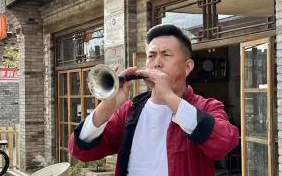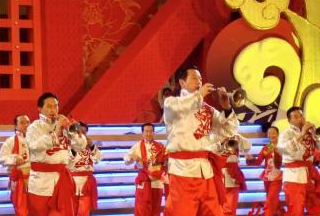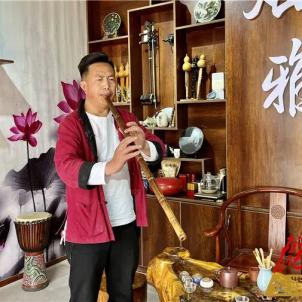Zhai Lipeng, Suona Municipal Inheritance Inheritance: Perseverance and Inheritance in the Sound of Suona
From the peasant child born in a "music family" to the city-level intangible inheritor of Qingyang Suona; from "early sound" to more than 30 kinds of musical instruments "at your fingertips"; from rural "career" to the big stage of CCTV, this year The 42-year-old Zhai Lipeng has come all the way with his obsession with folk music. He has put in hard work and sweat, and has received flowers and applause.

Zhai Lipeng is from Zhaijiazui Village, Hejia'ao, Wenquan Town, Xifeng District. Although he was born in the countryside, his family loves music. His father, Zhai Youjun, was a good suona player and was a famous person from all over the world. Anyone who had a wedding or a wedding would always invite him to play a few tunes. Mother Zhang Qiaofen also likes music and can play the erhu. My grandfather can sing opera, my uncle is also a good erhu player, and my cousin can even play the flute and harmonica. When a family gets together, it is a performance team, and Zhai Lipeng grew up in such an environment.
Since the age of eight or nine, his father taught Zhai Lipeng to play the suona, and his mother taught him to play the erhu. At that time, the learning was all based on feeling. When his father played a piece of music, Zhai Lipeng listened to it first, until he was familiar with it and could hum it, then he found this tune and that tone on the musical instrument, and gradually explored it. Even though it was a local method, it also made Zhai Lipeng really fall in love with it. music.
Later, his father asked Zhai Lipeng to study with his master Wang Xuan, and this study lasted for three years. In those three years, Zhai Lipeng often rode his bicycle to Master's house and learned to play the suona, pull the banhu, and play the drums. The process of learning a musical instrument is sometimes boring. When learning to pull a banhu, the master asked Zhai Lipeng to "empty pull" without pressing the strings, so as to exercise his wrist strength and control over the strings. "It is this repeated practice that has laid a solid foundation for my further study in the future," said Zhai Lipeng.
In 2000, when wind music was at its most prosperous time, when Zhai Lipeng participated in a company's opening event, he saw some people playing the trombone and some playing the erhu in the performance team. To play the suona, you should try to get in touch with more new musical instruments.
At that time, an orchestra advertised "the pioneer of Qingyang art, the cradle of national music", and Zhai Lipeng joined the orchestra. He was practical and serious, and soon became the backbone of the group. During this period, he also studied under the tutelage of Ma Zigang and others, the national intangible inheritor of suona in Qingyang, and devoted himself to the study of folk music. Zhai Lipeng found that he still loves ethnic music, no matter suona, flute, erhu, as long as he holds these ethnic musical instruments in his hand, he will have the urge to play. Standing on the stage, the whole stage is his world alone. He also has a unique skill, which is to use 10 musical instruments to string together, which has made him shine on many stages.
In 2008, Zhai Lipeng became a student of Mr. Liang Pingzheng, a suona artist in Qingyang. Seeing that Zhai Lipeng was talented, practical and eager to learn, Liang Pingzheng could not wait to pass on all his unique skills to Zhai Lipeng. The true sense of "literacy". If it is said that before 2008, Zhai Lipeng's musical talent was only displayed in the hot land of his hometown, then after 2008, he began to perform in the province and the whole country.

"A mature musician should not only study hard and practice hard, but also have rich experience in stage performance, and performing on stage can also improve people's leadership." This is Zhai Lipeng's experience. Since he was a teenager, he has been in the He performed suona and other musical instruments on the big and small stages, from ordinary red and white affairs to evening parties in the city and the province, and finally, he stepped onto the stage of the Great Hall of the People.
In 2008, the China Federation of Literary and Art Circles held the "Hundred Flowers Welcome Spring" party in the Great Hall of the People. The Gansu Provincial Department of Culture invited Qingyang folk music artists to perform in Beijing on behalf of Qingyang. For this program, Zhai Lipeng and more than 20 Qingyang folk musicians rehearsed together. For more than a month, they not only have to play, but also dance performances. After several twists and turns, Qingyang Suona finally entered the national stage.
In 2014, when Xiong Youtang, a famous singer in Qingyang, participated in the weekly performance of CCTV's "Avenue of Stars", Zhai Lipeng helped Xiong Youtang as a suonaist. In the end, Xiong Youtang and his team conquered all the audience at the scene and won the weekly championship of "Avenue of Stars" all the way.
With the continuous enrichment of performance experience, Zhai Lipeng's reputation has also grown. In 2011, he was named "Gansu Provincial Folk Artist", in 2015 he won the third prize in the Gansu Provincial Instrumental Music Competition, and in 2016, he won the "Shuangxin of Morality and Art" China The title of outstanding art teacher of literature and art.
With the expansion of influence, Zhai Lipeng's thinking has also changed. He wants to show and promote the folk culture of his hometown through music. To this end, he continued to enhance his playing ability and level, and continued to improve his knowledge level and musical skills. He frugally bought back CDs played by famous artists, and watched and speculated over and over again. In front of music, he was fascinated. drunk.
Now, Zhai Lipeng has mastered the playing methods of more than 30 musical instruments. "Each musical instrument has its own unique performance connotation, and my greatest hope now is to explore the cultural connotation of Qingyang and enhance the cultural influence of Qingyang." Zhai Lipeng told reporters .

On the evening of January 30 this year, Zhai Lipeng, who had just attended the "2022 New Year's Concert in Qingyang City", was driving on his way home. The north wind roared through the car window, watching the snow on the branches of the sidewalks on both sides. Su fell, and in an instant, Zhai Lipeng's heart flooded with infinite thoughts of his family. With this kind of emotion, Zhai Lipeng composed the music "Hometown Road", which kicked off with the melodious and melodious piano. With the addition of Xiao, in the whimpering and melodious voices, the figures of children running indulgently in the Loess Plateau seem to be appear in front of people's eyes.
This is not the only piece of music he has created. Since the idea of creating creation in 2017, he has composed music, played demos, and communicated with teachers and friends. So far, Zhai Lipeng has composed 5 pieces of music one after another.
"I want to create a variety of music with Qingyang characteristics, and show the charm of Qingyang's ancient farming civilization in multiple directions. For this reason, I travel around, feel the cultural customs and charms different from Qingyang, and learn local ethnic musical instruments. And integrate them into his own creation." Saying that, Zhai Lipeng picked up the xun and played the song "Northern Ancient Rhyme" he composed. With the simple and deep xun sound, people felt the solemnity of the vast and vast Loess Plateau. Some flavor.
In the continuous integration and mutual reference of art, Zhai Lipeng has a deeper understanding of Qingyang Suona. "Compared with the current 'popular' music, Qingyang Suona lacks the appeal to the audience." Zhai Lipeng said. Combining his own experience, he enhanced physical performance, rhythm and technical input in suona performance, making the performance more enjoyable to watch.
In August 2011, Ma Zigang initiated the establishment of the Qingyang Suona Art Professional Committee, which built a platform for the communication and exchange of Suona art. With the growing prosperity of Qingyang folk culture, Zhai Lipeng also wants to pass on his skills. In 2015, he established Fengya Folk Music Training Institute, and began to cooperate with primary and secondary schools to teach and guide children to understand, play suona, National musical instruments such as cucurbit flute, xun and sheng have brought Qingyang suona, a national intangible cultural heritage, into the school and planted in the hearts of children.
In 2018, Fengya Folk Music Institute was named "National Intangible Cultural Heritage Protection Project Qingyang Suona Art Institute" by Xifeng District Cultural Center of Qingyang City. He was also recognized as the municipal intangible inheritor of Qingyang Suona.
How to make Qingyang Suona form a systematic teaching material, teaching system and talent training model, and promote Qingyang Suona to go out of Qingyang and approach the young group, this is Zhai Lipeng's thinking in recent years, and it is also the direction of his exploration. "I will devote as much energy as possible to the inheritance and development of folk music. This is my original intention and dream that will never change," said Zhai Lipeng.
 渝公网安备 50010702504639号
渝公网安备 50010702504639号